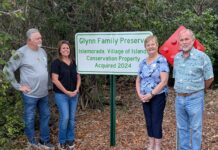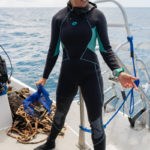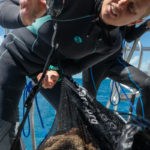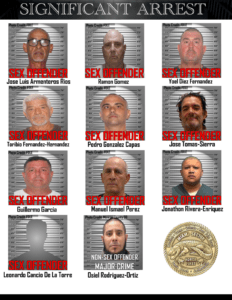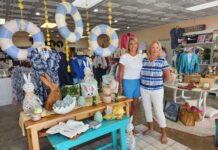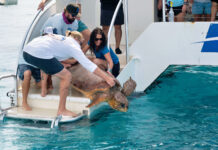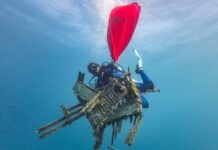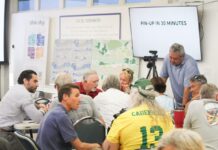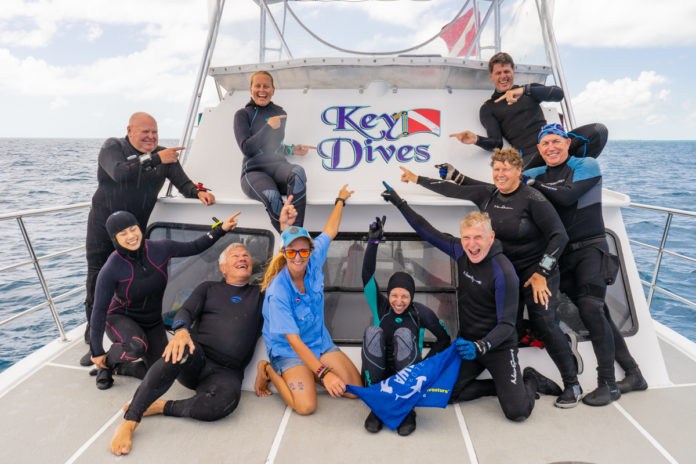
In July 2018, a small but mighty team of divers from Key Dives in Islamorada began bi-weekly clean-up scuba dives. Not quite two years later, they’ve surpassed a major milestone, pulling their 10,000th pound of ocean debris out of the water in early March, before the quarantine shutdowns began.
“It’s so exciting,” said marine conservation coordinator Cortney Benson of the mega-milestone. “What we’re doing is working. When we first started these dives, we’d get 500 to 700 pounds of debris on a single site. Now, if we get 100 to 200 on a site, it’s a ‘good’ site for cleanups.”
“Ten thousand is special, but it’s a scary milestone, really,” said owner Mike Goldberg. “You could do another dozen dives where we went today. You can tell where the guys fish ’cause that’s where everything is. There’s so much crap down there, we’ll have to come back.”

The team pulled up 334 pounds of line, traps and debris from the deep side of Alligator Reef, bringing their all-time total to 10,119 pounds removed from local waters.
Goldberg estimated that 15 to 20 locals come out regularly to help. He said, “It’s a great way for them to take pride in our backyard. The more people we involve, the more we can shift mindsets and achieve even more.”
“It’s been a long road, and it’s awesome to get here with the people on board today; they’ve been on 99 percent of cleanups, so to reach this big number with them is really special.”
– Michael Goldberg, owner of Key Dives
One of those divers, Tony Browne of Islamorada, estimated he’s been on “maybe 15” of the Dives Against Debris with his wife, Shelly Laughlin.
“We try to help and support our local shop,” said Tony Browne of Islamorada. “But it doesn’t matter how much debris we pull up; there’s always more. It’s never-ending.”
Laughlin called the trash situation “truly heartbreaking.” She said, “We are involved because we want the reef to be there for the kids. We look at our friends’ kids and think, ‘Oh my God, we gotta save the planet for them.’”
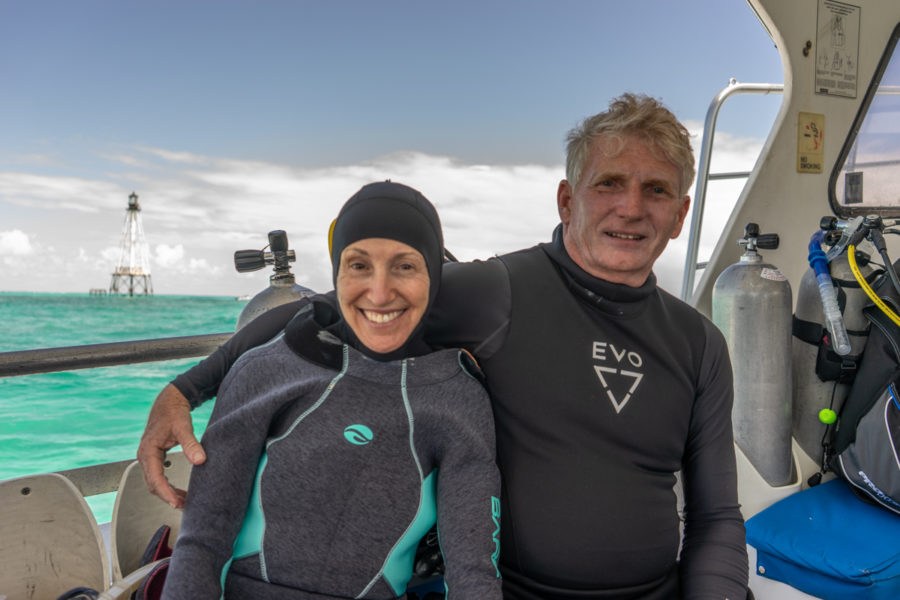
Marilyn Steadman of Key Largo, another regular at the dive shop, has been on almost all the dives.
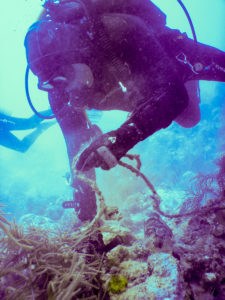
“We came out because the first time we came here was in January 1977, and we’ve seen the reefs go downhill since then,” she said. “So, we do as much as we can to restore the reef. If we want to go out and enjoy the ocean, we need to keep it clean.”
Kurt Tidd, another loyal participant who dives with his daughter Jacquelyn Tidd, praised Key Dives for its foresight, leadership and passion. He said, “This is my home dive shop. I love the fact that they’re trying to preserve the spectacular reefs we had. They’re so dedicated, and everyone — Mike, Cortney, Jason — they’re all terrific folks. They don’t just do it for the advertising. They truly care.”
Pointing to Jacquelyn, Tidd noted, “I do it for her. She rekindled why I love to dive and why I need to protect what we have. And they (Key Dives) make it so easy to help. I want her kids to be able to come here and dive.”
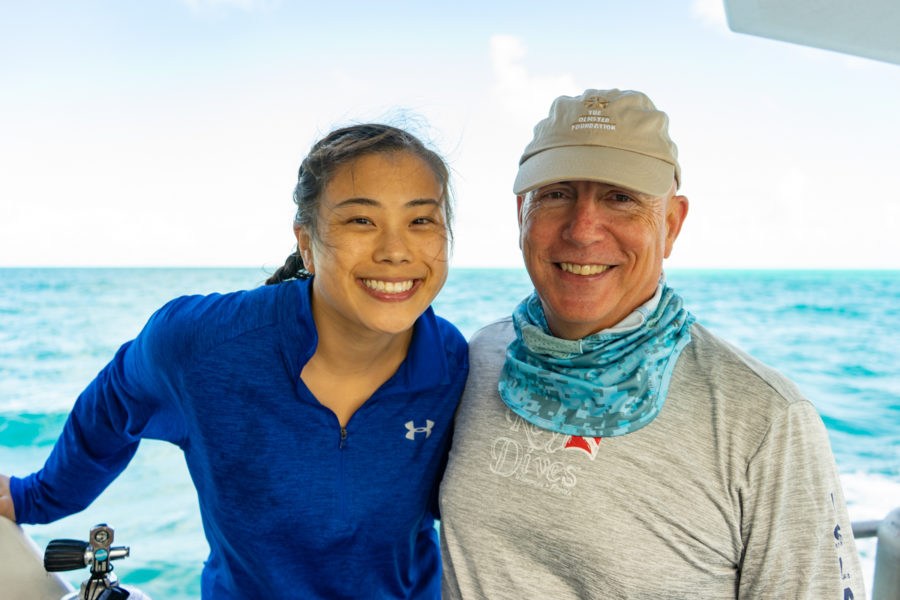
Goldberg credits NOAA and the National Marine Sanctuaries Foundation with the original idea and funding to work with the community to clean up the local environment. While the money has since dried up, Key Dives continues the practice because it is the “right thing to do,” said Goldberg. He estimates they’ve run 36 clean-up dives since the program’s inception.
“Cortney deserves credit for where we are,” he said proudly. “She’s the engine behind the cleanups and the driving force. Because of her, we’ve led the pack.”
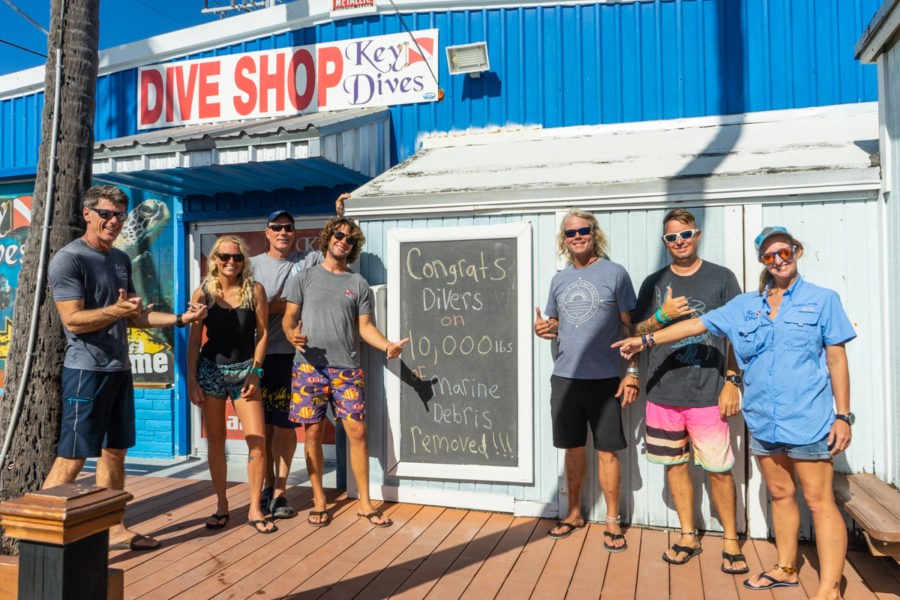
Other shops participate but none has reached the gargantuan 10,000-pound mark, yet. Benson hopes to reach out to other local shops to share lessons learned and to help create more similar programs.
“I think 10,000 pounds is quite a lot, and if all shops set that goal, it could really make a difference,” Benson said. “If businesses comprehended how good conservation is for business, that it makes people happy, they might realize it’s the way to go.
Key Dives isn’t stopping anytime soon. Thinking towards the next milestone, Goldberg said, “Two years from now, we’ll likely have another 10,000 pounds on top of this. We can go back to popular fishing spots and pull out a few hundred pounds after we do cleanups. We’ve still got a lot of work to do.”
Marilyn Steadman agreed, saying “I’ll keep going and helping until I can’t dive anymore. Hopefully forever.”

Lessons Learned from 10,000 Pounds of Debris Removed:
- “Make sure your anchors are tied on tight before you drop them. You don’t know how many anchors we pull up every single dive. Keep your trash bags tucked away. If you’re kayaking, make sure your trash is secure, especially if it’s windy.” – Marilyn Steadman
- “We’re desperate for more moorings. It’ll reduce a lot of the debris we see, because much of it is line, anchor and chains. I can tell the sanctuary exactly where we need to put them.” – Mike Goldberg
- “If you try diving for a purpose, you’ll get addicted. As for shops, they’ll learn how much they can gain from it. It’s eye-opening.” – Cortney Benson







